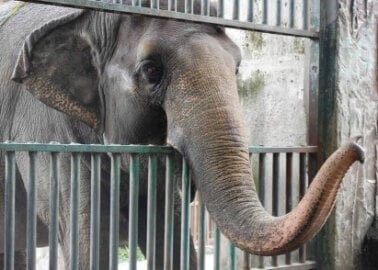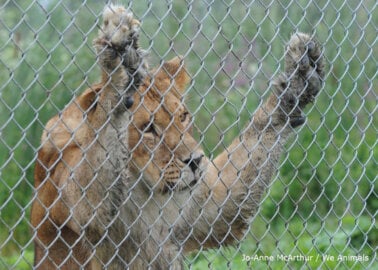9 Reasons Not to Visit Zoos
Zoos began as menageries where the rich could see living “exhibits” from foreign lands. The justification many zoos give for their existence in the 21st century is that they protect animals and conserve endangered species – but this isn’t true. These days, many people see zoos for what they are: animal prisons.
Read on to discover why nobody should ever support zoos.
1. Animals Suffer in Captivity
Why are zoos bad for animals? Captivity is living hell for animals, who are meant to be free. Enclosures in UK zoos and safari parks are on average 100 times smaller than the minimum home range for animals in their natural habitats.
In zoos, animals’ every decision – including what to eat, when to sleep, and whom they choose as a mate – is controlled by humans. They can’t roam vast distances or do many of the other things that are natural and important to them. Often, they aren’t even allowed stay with their families, as young animals are commonly transferred to other zoos.
The daily stress and lack of stimulation often leads to abnormal and self-destructive behaviour – for example, pacing, walking in tight circles, rocking, swaying, or self-mutilation – a condition known as “zoochosis”. This type of behaviour is almost unheard of in their wild counterparts. Zookeepers sometimes give the animals antidepressants, tranquilisers, or antipsychotic drugs to try to conceal their distress.
2. Many Zoos Fail to Provide Even a Minimum Standard of Care
Even in the best circumstances, it’s impossible for zoos to meet all the unique environmental, nutritional, climate, and social needs of the various species they hold captive – and some fail to provide even basic care. South Lakes Safari Zoo in Cumbria made headlines in 2017 when it was discovered that nearly 500 animals died there in under three years from causes ranging from malnourishment, hypothermia, and lack of veterinary care to outright neglect. A tortoise was electrocuted by the zoo’s wire fencing while lemurs and birds were run over by a toy train that went around the premise.
According to research conducted by Bristol University, more than three-quarters of British zoos failed to meet all the minimum animal-welfare standards.
3. Animals Are Taken From Their HomesZoos are still abducting animals from their natural environments in order to display them. Just recently, Borth Wild Animal Kingdom in Wales was responsible for the deaths of two lynxes who had been taken from their natural habitats and placed in enclosures that the zoo owners admitted were “not fit for purpose”. One lynx was killed after escaping, while the other was strangled to death while being moved to a different enclosure. And a few months ago, baby elephants were captured in nature and taken away from their mothers and herds before being sent to China to live a life of deprivation in zoos. As a result of inadequate space, food, water, and veterinary care, animals in zoos often suffer from debilitating health problems, and most die prematurely.
4. ‘Conservation’ Is a ConThe vast majority of species kept in zoos are not endangered. And while there’s a commonly held misconception that zoos reintroduce endangered animals into their native habitats, in reality, most zoos have no involvement of any kind with any reintroduction programmes. This means that captive-bred species that do face extinction – including elephants, polar bears, gorillas, tigers, chimpanzees, and pandas – are rarely, if ever, released into their natural environments to bolster dwindling populations.
5. All the Cages in the World Won’t Stop Animals From Going ExtinctWhile zoos spend millions on keeping animals confined, natural habitats are destroyed and animals are killed, as there’s insufficient funding for their protection. The only effective and sustainable way to save species is to support schemes that target the root cause of the extinction and endangerment of animals – habitat destruction. After all, what’s the point of breeding animals if they have no home left to go to?
6. Healthy Animals Are KilledZoos choose to breed animals because the public loves seeing babies. The breeding programmes serve no true conservation purpose, and under the guise of “species preservation”, many zoos get rid of “surplus” animals – either by killing them or selling them to unethical exotic-animal dealers. A giraffe named Marius was killed by Copenhagen Zoo and fed to lions, as he was considered useless for breeding. In one British zoo, the carcasses of slaughtered animals, including baboons and endangered deer, were left to rot beside bins.
7. Animals Are Trained to Perform TricksAnimals are not actors or spectacles to imprison and gawk at. Yet in many zoos, they’re trained to perform tricks as if they were in a circus. This year, a panda was made to paint through her prison bars as part of an attraction at an Austrian zoo, and the paintings were then sold online. In a zoo in Alabama , a red panda was made to do the same in an attempt to attract visitors. Back in 2010, an elephant at Woburn Safari Park in the UK was forced to obey the keeper’s commands through the use of high-voltage electric shocks. Disturbingly, animals have even been bred in UK zoos to be sold to circuses in other countries.
8. Kids Are Taught the Wrong LessonsA study of children between the ages of 7 and 15 who visited London Zoo found that for the majority of them – including those who took an educator-guided tour of the zoo – there were no positive educational outcomes. In many cases, the trip even had a negative impact on their understanding of animals and their habitats.
And that makes sense. We wouldn’t go to a prison to learn about typical human society, so why would we try to learn about animals by observing them in captivity?
At the end of the day, zoos are businesses geared towards entertaining people and making money – not educational establishments. They promote the misconception that it’s acceptable to interfere with animals and keep them locked up in captivity, where they’re depressed, cramped, and deprived of all control over their lives.
9. Animal-Protection Laws Are LackingSome species – animals like orcas or elephants who travel long distances in the wild, for instance – are particularly unsuited to captivity in any form. So any existing regulations do very little to stop the routine suffering that comes from denying animals their freedom and autonomy.
*****
Read more striking facts about zoos here.
What You Can Do
Please don’t visit zoos. Withhold your money from these inhumane establishments that profit from exploiting animals. We can protect endangered species by supporting habitat conservation – not animal prisons.
If you want to learn about animals, watch a nature documentary that shows how animals behave in their natural habitat. Or just look around you! Become an expert on the wildlife in your local area, from hedgehogs in your garden to birds flying overhead.




